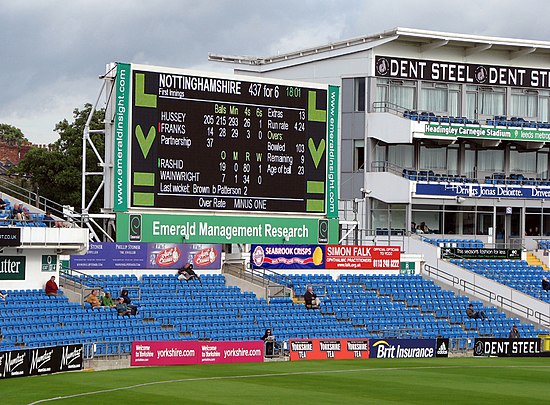An over rate is the average number of overs bowled per hour by the bowling team in cricket.[1][2] When calculated by Test match officials, allowances are made for wickets taken (2 mins per wicket), drinks breaks (4 mins each), DRS reviews, treatment for injuries, and other reasons,[3] which means the figure is higher than if calculated simply as the number of overs bowled divided by the number of hours of play.
In the highest levels of cricket, bowling sides are expected to achieve a minimum over rate. Bowling teams that have failed to achieve the minimum over rate have had points deducted,[4][5] the players fined,[6] or the captain suspended for future matches.[7] In international cricket and some leagues, the over rate penalty is that the fielding team is restricted to having fewer fielders in the outfield, making it easier for the batting team to hit boundaries.[8][9] It has been suggested that penalty runs could be imposed.[10]
- ^ "Over-rate definitions". yourdictionary.com. Retrieved 8 August 2020.
(cricket) The average number of overs completed per hour
- ^ "ICC Men's Test Match Playing Conditions Effective 1 September 2019". International Cricket Council. Retrieved 2 August 2020.
12.9.1 The minimum over rate to be achieved in Test Matches shall be 15 overs per hour.
- ^ "ICC Men's Test Match Playing Conditions Effective 1 September 2019". International Cricket Council. Section 12.9 Minimum Over Rates. Retrieved 8 August 2020.
- ^ "South Africa docked six WTC points, fined 60% match fees for slow over rate". ESPN. 27 January 2020. Retrieved 2 August 2020.
- ^ "Cricket Discipline Commission upholds Middlesex's two-point penalty". ECB. 17 October 2017. Retrieved 2 August 2020.
The two-point deduction from Middlesex CCC for a slow over rate will stand... it is noted that the requirement of 16 overs per hour is a minimum rate
- ^ "India cop over-rate fine for the second time in two matches". ESPN. 3 February 2020. Retrieved 2 August 2020.
After picking up a first over-rate offence in nearly six years, India have got two in two games, with the team fined 20 percent of their match fees for a slow over-rate in the fifth and final T20I against New Zealand.
- ^ "Cook handed one-match suspension". ESPN. 4 December 2014. Retrieved 2 August 2020.
Alastair Cook will miss the fourth one-day international against Sri Lanka after being handed a one-match suspension for England's slow over-rate in Hambantota on Wednesday.
- ^ "Slow over-rate penalty - extra fielder inside circle to be introduced in ODIs too". ESPNcricinfo. Retrieved 5 July 2023.
- ^ "Four, not five fielders allowed outside inner circle for slow over rate in T20Is". ESPNcricinfo. Retrieved 5 July 2023.
- ^ "World Cricket Committee endorses run penalties to keep over-rates in check". Wisden. 12 August 2019. Retrieved 2 August 2020.
"The committee feels that in-match five-run penalties would be the best deterrent to slow over rates," a statement said.
